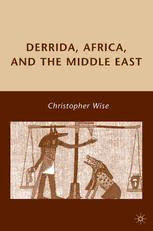
Derrida, Africa, and the Middle East PDF
Preview Derrida, Africa, and the Middle East
Derrida, Africa, and the Middle East Previous Publications Whither Arabism? (2009) The Yambo Ouologuem Reader (2008) Developing American Studies at Arab Universities (2004) The Desert Shore: Literatures of the Sahel (2001) Yambo Ouologuem: Postcolonial Writer, Islamic Militant (1999) Littératures du Sahel (1998) The Marxian Hermeneutics of Fredric Jameson (1995) Translation The Parachute Drop (2004), by Norbert Zongo Derrida, Africa, and the Middle East Christopher Wise Derrida, Africa, and the Middle East Copyright © Christopher Wise, 2009. Softcover reprint of the hardcover 1st edition 2009 978-0-230-61417-8 Earlier versions of the following chapters have appeared in the following journals: Chapter One, “Saying ‘Yes’ to Africa: Jacques Derrida’s Specters of Marx,” in Research In African Literatures, Vol. 33, No. 4 (Winter) 2002: 124–142; Chapter Three, “Deconstruction and Zionism: Jacques Derrida’s Specters of Marx,” in Diacritics, Vol. 31, No. 1 (Spring) 2001: 56–72; Chapter Four, “The Figure of Jerusalem: Jacques Derrida’s Specters of Marx,” Christianity and Literature, Vol. 54, No. 1 (Autumn) 2004: 73–91. Versions of these essays printed in this book supersede previously p ublished versions. All rights reserved. First published in 2009 by PALGRAVE MACMILLAN® in the United States—a division of St. Martin’s Press LLC, 175 Fifth Avenue, New York, NY 10010. Where this book is distributed in the UK, Europe and the rest of the world, this is by Palgrave Macmillan, a division of Macmillan Publishers Limited, registered in England, company number 785998, of Houndmills, Basingstoke, Hampshire RG21 6XS. Palgrave Macmillan is the global academic imprint of the above companies and has companies and representatives throughout the world. Palgrave® and Macmillan® are registered trademarks in the United States, the United Kingdom, Europe and other countries. ISBN 978-1-349-37839-5 ISBN 978-0-230-61953-1 (eBook) DOI 10.1057/9780230619531 Library of Congress Cataloging-in-Publication Wise, Christopher, 1961– Derrida, Africa, and the Middle East / Christopher Wise. p. cm. 1. Derrida, Jacques—Political and social views. 2. North Africans— France—Attitudes. 3. Derrida, Jacques—Religion. 4. Jewish philosophers—France—Attitudes. 5. Derrida, Jacques. Spectres de Marx. I. Title. B2430.D484W57 2009 194—dc22 2008030442 A catalogue record of the book is available from the British Library. Design by Newgen Imaging Systems (P) Ltd., Chennai, India. First edition: March 2009 10 9 8 7 6 5 4 3 2 1 For Judi, Zachary, Zoë, Ayesha, and Michael This page intentionally left blank Contents Preface ix 1 Saying “Yes” to Africa 1 2 Deconstruction of the Veil 13 3 Arab-Jew 27 4 Deconstruction and Zionism 45 5 The Figure of Jerusalem 59 6 Conjuration 75 7 The Secular Trace 89 8 The Double Gesture 107 9 Realism without Realism 129 10 The Wordless Yes 149 11 Deconstruction and the African Trace 167 Notes 189 Works Cited 201 Index 209 This page intentionally left blank Preface Every book has its story and this one, written between the turbulent years of 2001 and 2007, is certainly no exception. When I began this book, Jacques Derrida was still alive, the World Trade Centers in New York City were still erect, and the very notion of U.S.-led wars against Afghanistan and Iraq seemed little more than a fantasy of the far right. I was first drawn to Derrida as an Africanist scholar working in Sahelian literatures and society, especially Burkina Faso, Mali, Niger, and Senegal, but also further north into Morocco, Algeria, and Mauritania. Much of my research is focused on the culture of the Djoliba, one of the truly great river civilizations of the world, and I could see from my work among Fulani, Dogon, Songhay, and Mossi peoples that Derrida’s Specters of Marx especially resonates with Sahelian culture. This is so because the Sahel, in my view, is a culture that was influenced by Ancient Egyptian civilization. The Songhay language, for instance, is classified as a “Nilo-Sahelian” language, and cultural theorists have long studied links between the Songhay, the Fulani, the Dogon, and the Ancient Egyptians. To talk about links between Egypt and the Sahel is complicated for various reasons, not least because of the long history of Arabic slavery in the region and non-European and Arabic forms of racism toward black Africans. (The Fulani are a mixed ethnic group of both Arab and African ori- gins.) Specters of Marx begins with a discussion of the opening scene of Shakespeare’s Hamlet, as if it is a conjuration rite, and I had learned from my research in the Sahel that conjuration rites are common in this region in Sufi brotherhoods, especially among the Umarian Tidjaniya. My initial interest in Specters of Marx therefore grew out of my desire to better understand conjuration, not as some residue of archaic societies, but as a vital, fascinating, and contemporary practice in West Africa. No other serious contemporary philosopher offered as attractive a means for theorizing conjuration, so I began to read Derrida more seriously, despite my initial reservations about the appli- cability of deconstruction in this context. The more I studied Specters of Marx, and related texts like Archive Fever, Circumfession, and Veils,
